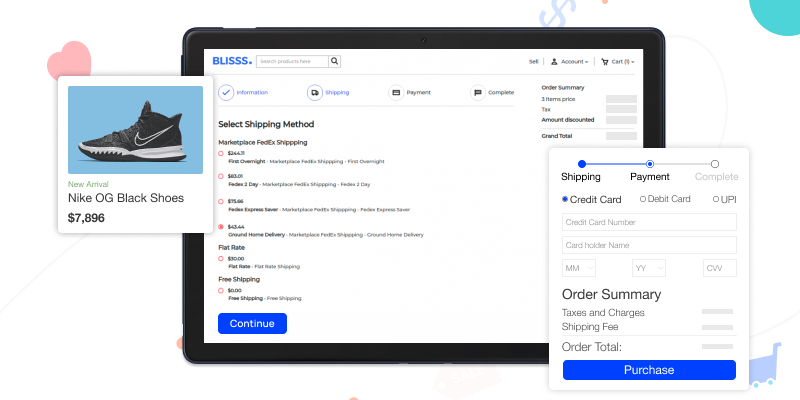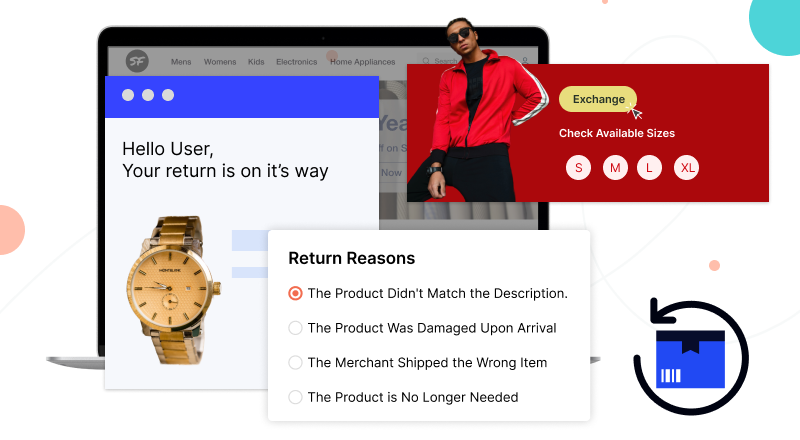Do you think, only setting up an eCommerce website is enough to go and gets your site up into the eCommerce digital marketplace?
Well, not actually, then what next?
You did a great job and spend lots of energy establishing an eCommerce website, but it does not mean your task is finally over and your website will start getting traffic.

At this stage, you don’t need a perfect website right away but a few things & strategies you have to consider to drive sales & engage visitors after you launch your eCommerce website.
Here, I am drafting out essential steps you need to follow when you are setting up your eCommerce.
#1 Set up payment and shipping methods
The purpose of e-commerce is to allow customers to check products and purchase from the comfort if it is from home on a mobile or laptop.
In this case, payment and delivery of products are critical parts of the marketplace.

Customers would expect to receive their product at their location, And instead of going to the store to make a payment, they would expect to make the payment online.
Today, store owners have many alternatives for online payment processing and shipping providers. So based on the region, customers can choose the payment and shipment partners as per their preference.
Such online payment options that are popular in the USA are Braintree, stripe payment gateway, Venmo, Apple Pay, and PayPal online payment methods which allow the store owner to have the ability for customers to make an online payment.
FedEx, Ship-rocket, and DHL shipping method are such examples of shipping companies that give the ability to the store owners to manage the delivery of products to the customer’s locations.
#2 Online marketing to bring new shoppers
eCommerce Marketing is a practice of using promotional tactics to maximize the stream of traffic toward the eCommerce digital marketplace.
Along with the sales traffic on the eCommerce digital marketplace, customer retention also plays a huge role in the successful marketplace.
A comprehensive eCommerce marketing strategy consists of both the ways on website & off website.

It can help store owners increase brand awareness, create customer loyalty and increase sales as well.
To retain old customers or acquire new customers, the store owner can use upselling.
The upsell is a famous example of approaching customers by offering a more premium version of the product that the customer was considering originally.
Sending newsletters
Email marketing is just a way to enlarge customer engagement, build brand loyalty and also build awareness for future upcoming promotions as well. It all results in boosting sales in the eCommerce marketplace.
Promotional emails
Promotional emails are those that the store owners send to the subscribers with useful content consisting of upcoming promotions or offers for specific products or brands.

To entertain the customers the store owner can send these kinds of emails as well.
- Welcome email
- Onboarding email
- Email for the abandoned cart
- Tips for shopping
- Flash deals
- Email for a VIP list
- Newsletters
Social media marketing
As the name Social Media marketing gives an idea, It means to promote the products or the brand through social media to generate more customer base and maximize the conversion as well.
Social Media can be a great tool for the store owner to drive referral traffic to the online marketplace or the store.

As per business insider social media is one of the largest waves in 2019, which helped the store owners to increase sales.
There are many ways Social Media Marketing can be used.
Organic social media marketing
In organic social media marketing, the customers can share the products as well through their posts on social media.

Like in many cases, we must have seen a post on social media where the products are tagged and when the users click on that they will be redirected to the products page on that social media from where they can place the orders.
Social media paid advertising
Social Media Paid Advertising is an example where the store owners pay the users on social media to promote their products through their social media accounts based on the click.

Here the users will earn through the number of clicks made on the user’s post.
This helps the store owner to increase the traffic through the users on social media and in order to get this done they are paying the users.
Influencer marketing
We all must have experienced the power of influencers with more than 1-2 million followers, where the influencer vouch for something or some product.
For instance, there is an incident for the dogecoin where ELON MUSK tweeted on his account and it resulted in a huge hike for more millions in value as per Forbes.

So, it is really a great idea most of the eCommerce digital marketplace owners are following nowadays to boost their sales as well through influencer marketing. Where they are paying the people with more huge follower count to vouch for their products resulting in creating sales.
#3 E-commerce site speed optimization
The online platform also allows you to reach a wider customer base, And it does not come automatically. For this, the store owner needs to optimize the website to achieve higher ranks on search engines.
So, the store owner needs to think as the customer and question themself like how a customer would want to reach your website and how they would want to search the specific item.

And then, based on the answers you find, you can improve the website accordingly.
There are options we can use for better performance through the speed optimization of eCommerce websites like lazy load, CDN, Image optimization, minification of assets, etc.
#4 E-commerce SEO
SEO is what plays a huge role in generating massive traffic on the website to generate more sales.
By managing the SEO, the ranking of products and websites can be improved so that whenever the customer searches for the products or the marketplace your website will be listed on the top of the first page.
In SEO, certain things need to be set up as per the data available on the website Meta Title, Right Keyword, and URL. Because with the help of these, you can improve the product and website listing on the internet by improving the rank.

To check the score of your website for ranking you can follow certain SEO guidelines by Google or you can also follow the Google Core Web Vitals. These are what help you to keep the score of your website in check and improve the same.
Shopping Feed
Shopping feed plays a huge role in the digital market in promoting products or brands through different platforms.
Google Shopping Feeds,
These feeds are like an advertisement on the platforms.
For example, when a customer searches for a Product iPhone on Google they see small ads on the Google search page or the Facebook page as well.
Google Ads
Google ads help in maximizing the store owner’s customer traffic on the website, By allowing the store owner to place their ads on the Google search page.
So that whenever a customer searches for any specific products, the products of the store owners will be shown on the search as per the plan opted by the store owner and as per their SEO or the overall website score as well.
#5 E-commerce site security
eCommerce digital marketplace gives store owners the reach to a huge customer base. It also increases the threat to the customers’ private data, payment, and card details.
It is the store owner’s responsibility to ensure the confidentiality of the customer and the payment data of the website.
There are many instances where the fake customer places an order with fake details.

In contrast to above mentioned points the store owner can have additional verification features on the store which can help the store owner in that matter.
One time password
Store owners can add the One Time Password verification through the mobile number whenever the customer registers on the marketplace or whenever the customer places an order so that it will have a verified customer with the verified mobile number.
Email verification
At the time of registration, the customers are required to provide their email id. Before proceeding to completely register the website the store owner can add a layer of verification through email, in this case, the email will verify with the code received in the email to confirm factual customers.
Two-factor authentication
As more and more customers are placing orders on the eCommerce digital marketplace store owners need to step up their game for security to avoid fraudsters on the eCommerce marketplace.
For this store, owners have complex passwords and are also requiring customers to use complex passwords with complicated formats with mixtures of multiple types of characters.
Two-Factor Authentication requires a token or security question from customers that only customers can solve so that it would ensure that they will not be the victim of scams.
Customers will also get confidence with such kind of security and place the orders on eCommerce website without any fear.
There are certainly other options for device security concerns like VPN, Content encryption, Updated Software, Monitor of corporate devices, etc.
To reduce these the store owner can add a verification process through Mobile number verification for the customer’s genuine profile.
There are many such examples that this would play out like spam, malware, etc.
For this, the better option is to check out eCommerce site security to stay updated with continuous logging & monitoring and have backups of the data as well, hardened security, and implementation of HTTPS security headers.
#6 Improving E-commerce site search
Most customers prefer to shop elsewhere if the website is designed with poor search and filter functionality.
It is no doubt that everyone is expecting better search filters due to our experience with the search filters of big giants like Amazon, and Flipkart.
To improve the site search the store owner can use better search engines as well on the website.

In contrast to the above-mentioned points, Store owners need to keep certain things in mind before finalizing any search engines based on these factors.
Ease of use: It should be easy to set up and use.
Accuracy: You need a search engine that is accurate so that the costumes would get the results with better accuracy upon their search.
Price: You should get search engines that are affordable so that you can get the most outcome for your bucks.
Customer support: You want a search engine that has fast and reliable customer support so that whenever there is any issue you can get support quickly as search engines will play a huge role in the eCommerce digital marketplace.
In contrast to the above-mentioned points, We have listed certain Search Engines below which you can check out.
ElasticSearch
Elasticsearch is one of the best open-source search engines. It supports all types of data including textual, numerical, structured, non-structured, geospatial, etc.
It is widely used for Website search, application search, enterprise search, logging and log analytics, application performance, and monitoring.
ElasticSearch in eCommerce provides Scalability, Speed, and resiliency along with several powerful built-in features that make searching and storing data even more efficient.
Algolia
It is an AI Powered search and discovery platform. With the help of this search engine businesses are getting a dynamic experience due to the maximized speed of search ad discovery by solving complex AI problems.
Algolia in eCommerce is a cloud-native application that is good as per the time and the evolution of technologies, And as the Algolia search engine is cloud-native based, it is faster than most of the other search engines.
Solr
Solr is one of the oldest search engines both Solr and Elastic Search have similar features that support fast search and discovery. The list goes on with full-text search, real-time indexing, dynamic clustering, and more. Being an old search engine Solr supports both RDBMS such as oracle and modern databases like NoSQL.
eCommerce digital marketplace is not just a page to purchase products, As they have much functionality with the mini storefront.
And this is where the customers can check all the products and their other offerings as well.
This is where the search engine comes in and makes the search & filter easy for the customers to have a satisfactory experience.
With the eCommerce search engine and filter, the store owner can improve the search suggestions in eCommerce website by using multiple filters based on the keywords and give a satisfactory result to the customer.
In today’s world, It is now a greater option to provide search suggestions in eCommerce websites, to the customers for the products based on their search history which generally compels the customers to think about the product to purchase.
#7 Exchange & return management
In the market, There are many instances where the customers are not satisfied with the products or they get defective products. They can easily return or exchange the same in the store.
In contrast to the above-mentioned case, there are better options for managing this and reducing the chances of the Return.
RMA (return merchandise authorization)
To get the confidence for their satisfaction they would look for the same option of return and exchange in eCommerce marketplace as well.
And it would not be easy for the customers or they would not want to go to the store for such services.

It would be a better idea for the customers to get this ability or the option to exchange or return the product to the store owner. Of course, with limitations like within the number of days, the customer can avail of this feature.
Virtual try on
Nowadays many eCommerce digital marketplaces are providing the ability to the customer option of trying on certain products through virtual try on.
With the help of this feature through AI the customers can now try out the products to see how it looks like if they have the products like Spectacles, Caps, etc.

This way before getting the products in hand the customer can try out the product virtually. One such example of the market using this feature is Lenskart.
In LensKart almost every one of us has tried this feature of trying out the spectacles through the phone camera.
Web AR
With the help of this Web Augmented reality, customers can try out the big and physical products like how they would look if it is placed in the respective space for which this specific product is to be purchased.

For example, if the customer wants to purchase a chair online. The customer can just try out the looks of this chair at a specific place in the home or office with the help of the camera like in Furlenco.
Conclusion
Just setting up the website in the digital market, is not enough to generate sales, And ensure customer satisfaction and retention.
There are many plays after setting up the website like the marketing strategy and providing more comfort and confidence to the customers regarding the brand and the products.
To retain a customer it is required to keep the customers entertained within the eCommerce digital marketplace, And we have provided various ways to do so in the above article.
So, that was much about the What to do next after setting up your eCommerce website?
For any queries or doubts reach out to us at [email protected]. You can also raise a ticket at our HelpDesk System.
Please explore our Laravel Development Services and Quality Bagisto Extensions.



Be the first to comment.